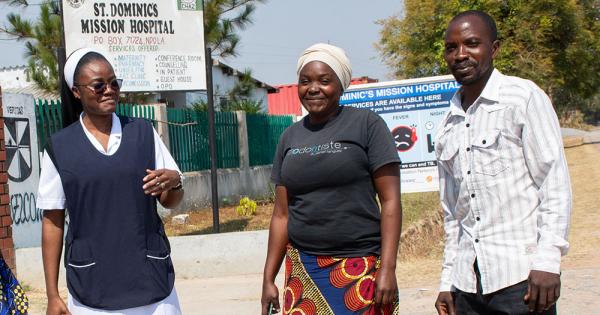One woman being treated for tuberculosis, no outbreak happening at Cedar Point dorms – WTVG

Public Health Report: Isolated Tuberculosis Case in Erie County
Executive Summary
Health officials in Erie County, Ohio, have confirmed a single, isolated case of active tuberculosis (TB) in an international worker designated for employment at the Cedar Point amusement park. A comprehensive public health response, aligned with key Sustainable Development Goals (SDGs), successfully contained the situation and prevented any community transmission. This report details the incident, the public health measures undertaken, and the connection to global health and development objectives.
Alignment with SDG 3: Good Health and Well-being
Case Identification and Containment
The management of this case directly supports SDG Target 3.3, which aims to end the epidemics of communicable diseases, including tuberculosis, by 2030. The response was characterized by swift and effective action:
- Initial Alert: The Erie County Health Department was notified by the U.S. State Department of a potential active TB case involving a woman from Columbia who had arrived in the area approximately 11 weeks prior.
- Immediate Isolation: The individual was located and isolated before she could begin her work shifts at the amusement park, thereby eliminating the risk of workplace transmission.
- Diagnosis Confirmation: The patient was confirmed to have an active case of TB, which investigators believe was contracted in her home country prior to her arrival in the United States. She was asymptomatic upon entry.
Proactive Screening and Public Health Assurance
To ensure community health and safety, the Erie County Health Department implemented robust screening protocols:
- Comprehensive Testing: Health officials conducted testing for 100 individuals residing in the same dormitory facilities.
- Test Results: No other individuals tested positive for active TB.
- Follow-up Investigation: Subsequent follow-up tests yielded two false-positive results, which can occur due to prior childhood infections. Further investigation confirmed that these two individuals, also from other countries, did not have active TB.
These measures underscore a commitment to SDG 3 by ensuring the health and well-being of the community through preventative action and thorough diagnostics.
Intersection with Broader Sustainable Development Goals
SDG 16 & 17: Strong Institutions and Partnerships
The successful handling of this health event highlights the importance of effective, accountable institutions and multi-stakeholder partnerships. The seamless collaboration between a national entity (State Department) and a local public health body (Erie County Health Department) was critical for the rapid identification and management of the case, demonstrating a strong framework for public health governance.
SDG 8 & 10: Decent Work and Reduced Inequalities
This incident also touches upon the goals of ensuring decent work and reducing inequalities. By providing comprehensive medical treatment and ensuring the individual’s health and safety, the response reflects a commitment to protecting vulnerable populations, including migrant workers. The provision of care, regardless of the patient’s country of origin, affirms the principle of equitable access to healthcare services, a cornerstone of SDG 10.
Conclusion and Patient Status
The Erie County Health Commissioner has officially stated that at no point was there a tuberculosis outbreak at Cedar Point or in the wider county, correcting misinformation that had circulated online. The single patient is responding well to treatment, and her condition is improving. Upon completion of her treatment course, she will be returned to her home country. The incident serves as a model for effective public health response, demonstrating how localized action can align with and support global Sustainable Development Goals.
1. Which SDGs are addressed or connected to the issues highlighted in the article?
Explanation
- SDG 3: Good Health and Well-being
The article’s central theme is a public health response to an infectious disease, tuberculosis (TB). The entire narrative focuses on the actions of health officials to identify, treat, and contain the disease to protect the health of the individual and the wider community. This directly aligns with the primary goal of SDG 3, which is to ensure healthy lives and promote well-being for all.
2. What specific targets under those SDGs can be identified based on the article’s content?
Explanation
- Target 3.3: By 2030, end the epidemics of AIDS, tuberculosis, malaria and neglected tropical diseases and combat hepatitis, water-borne diseases and other communicable diseases.
- The article is explicitly about a case of tuberculosis. The response from the Erie County Health Department, which included isolating the patient, providing treatment, and testing contacts, represents direct actions to combat and prevent the spread of a communicable disease. The health commissioner’s clarification that “At no point was there a tuberculosis outbreak” underscores the successful effort to prevent an epidemic.
- Target 3.d: Strengthen the capacity of all countries, in particular developing countries, for early warning, risk reduction and management of national and global health risks.
- The article showcases a functional system for managing health risks. The communication from the “State Department” to the “Erie County Health Department” about a “possible active TB case” acts as an early warning. The subsequent actions—locating the person, isolating her, and “testing on 100 people”—demonstrate a clear capacity for risk reduction and management of a potential public health emergency.
3. Are there any indicators mentioned or implied in the article that can be used to measure progress towards the identified targets?
Explanation
- Indicator 3.3.2: Tuberculosis incidence per 100,000 population.
- The article provides the fundamental data for this indicator by stating there was “only one person tested positive.” This establishes the incidence (the number of new cases) as one. The entire public health effort described was aimed at keeping this number from increasing, thereby directly measuring progress against the spread of TB in the community.
- Indicator 3.d.1: International Health Regulations (IHR) capacity and health emergency preparedness.
- The article provides a qualitative demonstration of this indicator. The successful coordination between state and local health departments, the rapid response to “track down the person in question,” and the implementation of public health protocols like isolation and contact tracing are all evidence of a functioning health emergency preparedness system. The successful containment of the disease to a single individual is a direct measure of this capacity’s effectiveness.
4. Table of SDGs, Targets, and Indicators
| SDGs | Targets | Indicators |
|---|---|---|
| SDG 3: Good Health and Well-being | 3.3: End the epidemics of… tuberculosis… and other communicable diseases. | 3.3.2: Tuberculosis incidence. The article specifies the incidence as “only one person tested positive.” |
| SDG 3: Good Health and Well-being | 3.d: Strengthen the capacity… for early warning, risk reduction and management of national and global health risks. | 3.d.1: International Health Regulations (IHR) capacity and health emergency preparedness. The article demonstrates this capacity through the coordinated response of health departments, including tracking, isolation, and contact tracing of 100 people to prevent an outbreak. |
Source: 13abc.com

What is Your Reaction?
 Like
0
Like
0
 Dislike
0
Dislike
0
 Love
0
Love
0
 Funny
0
Funny
0
 Angry
0
Angry
0
 Sad
0
Sad
0
 Wow
0
Wow
0

















































































